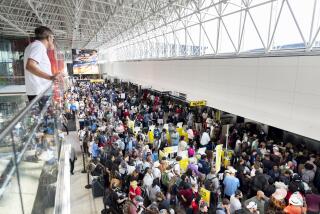Eyewitness Accounts of Russian Crisis at Your Fingertips
- Share via
Ferdi Serim and his students had been checking the computer screen for days, anxiously awaiting word from a Russian friend who had returned to Moscow--just in time for the city’s bloodiest explosion of political violence since the Bolshevik Revolution.
Finally, the welcome transmission began to roll by:
“To: Ferdi. Re: Peace and Safety to you and yours. Thank you for your solidarity: Please find some recent news.”
The message was from Anatoly Voronov, director of the Glasnet electronic network in Moscow. He went on for 200 computer-screen lines, describing what he had witnessed as the violence began to wind down:
“At 8 in the morning Radio Russia reported that up to 9 heavy tanks had broken the barricades around the ‘White House’ (Parliament) building located some blocks from the American Embassy in downtown Moscow
“I still get chills thinking about it,” said Serim, who teaches computer literacy, with an emphasis on multiculturalism, at an elementary school in Plainsboro, N.J. The experience reinforced his belief that the global linking of computers signals a revolution in the way we receive information.
“We could see and hear what was happening from Anatoly’s vantage point,” he said. As further verification, he was able to put the first-hand report on the new Scholastic Network, which was launched only last week by Scholastic Inc. Publications and America Online to link classrooms and teachers throughout the United States.
“My students were actually talking to people who were watching tanks roll in the streets,” Serim said.
For the moment, he and his fifth-graders were better connected to Russia’s political turmoil than the most news media.
“Forget faxing and forget overnights,” he said. “Just about anything you can pick up in a newspaper or see on TV can be received on a personal computer now.”
If China’s 1989 Tien An Men Square revolt brought the phone and fax into the limelight as cutting-edge information technology, last week’s Battle of Moscow dramatized the new role of computer as information machine, particularly for the powerful system known as Internet.
“In the case of China, everybody was kind of surprised by how much informationthere was,” said Paul Saffo, technology expert at Menlo Park’s Institute for the Future. “But this time, everybody expected Internet to be chock-full of insights and information about what was happening in Russia. There was no surprise. That’s what is different.”
Formed 20 years ago by the Defense Department as a way to exchange research data, Internet has developed into a worldwide linkup of more than 14,000 computer networks, which reach an estimated 15 million people. With a heavy concentration of business and academic users, it is also becoming an increasing attraction for everyday consumers, although even its biggest fans acknowledge that its esoteric language and complex commands are daunting. (A sample: “telnet to rusinfo. rus.uni-stuttgart.login info. go to directory/news-server.”)
In San Diego, where an Internic) reference office helps novices through Internet, staffer Susan Calcari studied the message postings and reported a surge in traffic last week as Moscow’s crisis escalated.
“There are lots of (user groups) discussing what’s going on over there,” she said. “The advantage (over fax or telephone) is you have a ‘one-to-many’ ratio. That means someone in Moscow could send a report to me and I’ll put it on various mailing lists. It goes all around the world.”
The result is a global talk show. Some users posted questions (“Is Yeltsin on the Internet? Can someone contact him via Reuters (news service) or somehow?”), while others announced the availability of research files, press releases or pertinent political articles. And in computer discussion groups, often Russian studies groups, students and professors jumped in to give their own opinions as events unfolded.
In addition to Internet, computer browsers also received news on the Russian crisis with other commercial on-line services, including CompuServe, Prodigy and America Online.
At America Online’s Vienna, Va., headquarters, Jean Villanueva typed “Moscow” for a news search one morning last week and found 114 stories in the file. “These are today’s stories, from various news sources, not archives,” she said. “You really can get a very full view of any breaking news.”
Although only 4% of personal computer households currently have access to such on-line networking, Villanueva said, the growth is happening much more rapidly than any previous technology. “Our company was founded in 1985 and is growing an annual rate of 80%.”
One reason is the increased accessibility of the technology. For less than $1,000 today, one can buy a computer and modem--the device that sends and receives computer information over the telephone line, connecting the user to the entire world.
“The rate of growth is the curve you have to be looking at right now,” said Howard Rheingold of Sausalito, editor of Whole Earth Review and author of “The Virtual Community,” a new book from Addison Wesley Publishers tracing the growth of worldwide computer culture. He followed the Moscow uprising last week on the WELL (Whole Earth ‘Lectronic Link), one of the smaller commercial services that runs computer-user bulletin boards and sells Internet access.
“What’s happening? I tune into the WELL and my friend Chuck’s daughter is sending E-mail from Moscow, where she is working,” he said. “We are reading eyewitness reports on the WELL, as it happens. What this says is that everyone is a potential eyewitness to history.”
No one knows what the outcome of this revolution will be, he adds, but no one can afford to ignore it.
“Maybe you didn’t understand the cathode ray tube in 1951, but television changed the world. Internet is not just for nerds, it’s for everyone, and everyone had better learn about it.”
More to Read
Sign up for Essential California
The most important California stories and recommendations in your inbox every morning.
You may occasionally receive promotional content from the Los Angeles Times.













